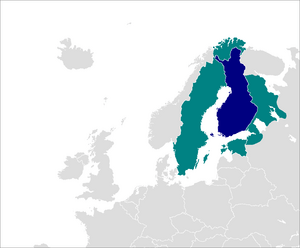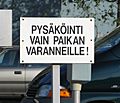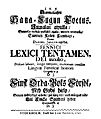Finnish language facts for kids
Quick facts for kids Finnish |
||||
|---|---|---|---|---|
| Suomen kieli | ||||
| Native to | Finland, Estonia, Ingria, Karelia, Norway, Sweden | |||
| Native speakers | c. 5 million (2011) | |||
| Language family |
Uralic
|
|||
| Writing system | Latin (Finnish alphabet) Finnish Braille |
|||
| Official status | ||||
| Official language in | recognised as minority language in:
|
|||
| Regulated by | Language Planning Department of the Institute for the Languages of Finland | |||

Official language. Spoken by a minority.
|
||||
|
||||
Finnish (Finnish: Suomen kieli) is a Uralic language. It is one of the two official languages of Finland. It is also an official minority language in Sweden. Finnish is one of the four national languages of Europe that is not an Indo-European language. The other three are Estonian and Hungarian, which are also Uralic languages, and Basque.
Contents
Related languages
The Finnish grammar and most Finnish words are very different from those in other European languages, because Finnish is not an Indo-European language. The two other national languages that are Uralic languages as Finnish are Estonian and Hungarian. Estonians and Finns usually may understand each other, but their languages are very different. Even though Finnish and Hungarian are related languages, they do not look or sound similar. The Finnish and Hungarian languages separated a long time ago, and each language developed its own vocabulary. People who can speak Finnish cannot understand Hungarian without extra study, and Hungarians cannot understand Finnish. However, there are some basic words that are very similar, for example: 'hand' (Finnish 'käsi' vs. Hungarian 'kéz') 'to go' (Finnish 'mennä' vs. Hungarian 'menni'), 'fish' (Finnish 'kala' vs. Hungarian 'hal').
Finnish grammar
Finnish is a synthetic and an agglutinative language. This means that words in Finnish have a stem called "body", and other parts inside them which make up the meaning. Finnish is similar in this respect to the Japanese language, Turkish language, and Latin language. In Finnish, there are 17 cases/word types (sanatyypit). You can think of a "case" as an ending added to a word that helps describe its purpose in the sentence. Verbs have 5 tempora (present tense, past tense, perfect, pluperfect and future tense). In addition, verbs have two participle (active and passive) cases. Gerunds, which are nouns made from verbs (for example: reading - to read) also exist in Finnish (lukeminen - lukea), are abundant in Finnish.
Finnish is a complex, self-morphing language. It has been ranked as a highly difficult language for native speakers of English by the U.S. Department of State. The difficulty is due not only to the grammatical structure of the language, but also pronunciation and intonation as compared to English.
Finnish spelling and pronunciation
Finnish is pronounced the way it is spelled. The pronunciation of some letters is similar to English. However:
- 'j' is like English 'y' in 'yes'
- 's' is like English 's' in 'sad' (never like 'z')
- 'h' is always pronounced, even at the end of a syllable e.g. 'ahdas' ('narrow')
- double vowels make the sound long
- 'ä' is similar to 'a' in English 'cat'
- 'ö' is almost like English article 'a'. It is pronounced with rounded lips, like 'eu' in French 'peur' or German 'ö'
- the letter 'c' is not used. It is replaced either by 'k' or 's' to avoid confusion and make writing simple.
- the letter 'q' is not used. It is replaced by either 'k' or 'kv' to make writing simple.
- the letter 'y' is pronounced like the 'u' in French language, or 'i' in 'in' but with rounded lips, very close to 'ö'.
- the letter 'z' is pronounced 'ts' as in German language. It is often written as "ts" to make writing simple.
- the letter 'x' is usually written out as 'ks' to make writing simple, for example in the word "taksi" instead of "taxi".
English speakers often exhale when saying letters like "k", "p", and "t". They don't do this in Finnish, and to "swallow the sound", as the old saying goes, takes a lot of practice.
The proper pronunciation for the Finnish diphthongs (öy, yö, äy, eu, etc.) is difficult.
Examples of Finnish words
| Yksi | One |
| Kaksi | Two |
| Kolme | Three |
| Kyllä | Yes |
| Ei | No |
| Minä | I |
| Sinä/Te | You |
| Hän | He/She |
| Me | We |
| He | They |
| Olen/Minä olen | I am |
| Suomi | Finland |
| Talo | House |
| Koti | Home |
| Tie | Way |
| Äiti | Mother |
| Isä | Father |
| Tyttö | Girl |
| Poika | Boy |
| Vauva | Baby |
| Auto | Car |
| Juna | Train |
| Lentokone | Airplane |
| Ravintola | Restaurant |
| Nukke | Doll |
| Sänky | Bed |
| Tuoli | Chair |
| Kaupunki | City/Town |
| Puisto | Park |
| Polkupyörä | Bicycle |
| Kukka | Flower |
| Kevät | Spring |
| Kesä | Summer |
| Syksy | Autumn/Fall |
| Talvi | Winter |
Basic Finnish expressions
| Terve | Hello |
| Mitä kuuluu? | How are you? (informal) |
| Kiitos hyvää | Very well, thank you |
| Kiitos | Thank you |
| Kiitos paljon | Thank you very much |
| Hyvää huomenta | Good morning |
| Hyvää iltaa | Good evening |
| Hyvää yötä | Good night |
| Hyvästi | Goodbye |
| Nimeni on Anna | My name is Anna |
| En osaa puhua suomea | I can't speak Finnish |
| Puhutteko englantia? | Do you speak English? |
Images for kids
-
Mikael Agricola, a 19th-century drawing by Albert Edelfelt
-
Elias Lönnrot as depicted in a 19th-century caricature – Lönnrot made several journeys to Karelia and Eastern Finland to collect folklore, from which he compiled the Kalevala.
-
The Turku dialect is famous for its seemingly inverted questions. For example, "Ei me mittä kaffelle men?" looks like it means "So we don't go for a coffee?" but actually means "Shall we go for a coffee?"
-
The first page of Abckiria (1543), the first book written in the Finnish language. The spelling of Finnish in the book had many inconsistencies: for example, the /k/ sound could be represented by c, k or even g; the long u and the long i were represented by w and ij respectively, and ä was represented by e.
See also
 In Spanish: Idioma finés para niños
In Spanish: Idioma finés para niños









